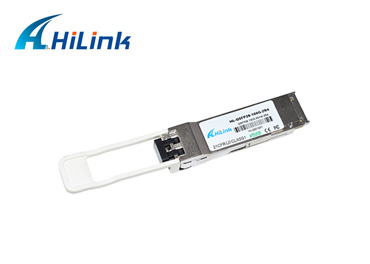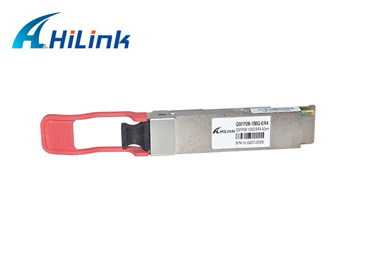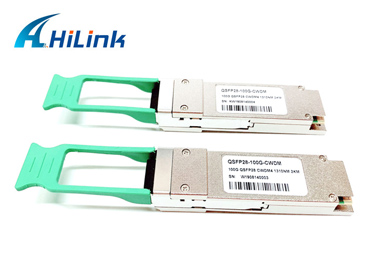How to Choose a QSFP+ Transceiver?
Jul. 07, 2022
The 40G Ethernet standard is now a popular choice for the rapid growth of regional and local fiber optic communication networks worldwide. For 40G network applications, two different package forms of fiber optic transceivers are commonly used, the QSFP+ transceiver (quad small form-factor pluggable plus transceiver) and the CFP transceiver (C form-factor pluggable transceiver). QSFP+ transceivers are more popular for 40G applications. Today we will discuss how to select a 40GBASE QSFP+ transceiver. There are several factors to consider when choosing one, such as media system, connector type, transmission distance, wavelength, etc., and we will talk about each of these factors below.
Fiber type
First, choose the right QSFP+ transceiver based on the transmission media, i.e. fiber type. According to the IEEE 802.3ba 40G Ethernet standard, three types of transceivers are used in each of the three transmission media: single-mode fiber (SMF), multimode fiber (MMF), and copper wire.
Hilink 100G QSFP28 ZR4 Optical Transceiver
SMF: 40GBASE-LR4 QSFP+ transceivers reach 40 Gb/s Ethernet over four wavelengths carried by single-mode fiber optic cables.
MMF: 40GBASE-SR4 QSFP+ transceivers reach 40 Gb/s Ethernet over four short-haul multimode fiber optic cables.
Copper: 40GBASE-CR4 QSFP+ transceivers reach 40 Gb/s Ethernet over four short-haul dual-axis copper cables bundled as a single cable over a standard G.652 single-mode fiber pair.
Interface Type
Select the correct transceiver compatible with the correct connector. The main types of connectors in widespread use are the following: duplex LC connectors and MPO connectors (or MTP connectors, a high-performance MPO connector). For example, the Cisco QSFP-40G-LR4 40GBASE-LR4 QSFP+ transceiver is compatible with the duplex LC connector, while the Cisco QSFP-40G-SR4-S 40GBASE-SR4 QSFP+ transceiver and the HP JG709A 40GBASE-CSR4 QSFP+ transceiver are compatible with the MPO connector.
100G 40KM QSFP28 ER4
Wavelength
The wavelength at which the QSFP+ transceiver operates is another important factor in selecting the right QSFP+ transceiver. For example, the QSFP-40G-LX4 QSFP+ transceiver converts four input channels (1271nm, 1291nm, 1311nm, 1331nm) of 10Gb/s electrical data into four CWDM optical signals and multiplexes them into one channel for 40Gb/s optical transmission. Some other QSFP+ transceivers (such as the QSFP-40GBD-SR QSFP+ transceiver) consist of two 20-Gbps transmit and receive channels in the 832-918 nm wavelength range.
Transmission Distance
The actually required transmission distance and reach requirements also need to be considered when selecting the most appropriate QSFP+ transceiver. The most common types of QSFP+ transceivers are classified by their transmission distances up to 100m, 150m, 300m, 400m, 1km, 2km, 10km, 40km, etc. For example, 40GBASE-LR4 QSFP+ transceivers are available up to 10km for long-distance transmission, while 40GBASE-LX4 QSFP+ transceivers are designed to support link lengths of 100m and 150m on laser-optimized OM3 and OM4 multimode fiber cables, respectively. There are others, such as the 40GBASE-ER4 QSFP+ transceiver, which supports link lengths up to 40km on single-mode fiber optic cable and is intended for long-distance transmission.
100G QSFP28 CWDM4 2KM
Cost
The total cost of a QSFP+ transceiver is a significant amount of money. Cost is one aspect to consider when selecting a 40G QSFP+ transceiver. For a limited BUGET, you have to find out the best option. Third-party transceivers that are compatible with various types of switches can be found on the market today. They offer the same performance as the original brand transceivers, but at a lower cost. Choosing a compatible QSFP+ transceiver has become the choice of many data centers and they must be selected from companies that guarantee 100% compatibility and interoperability.
Overview
Before choosing a QSFP+ transceiver, first, figure out what kind of QSFP+ transceiver you need. Whether you need a single-mode fiber QSFP+ transceiver or a multimode fiber QSFP+ transceiver, a duplex LC connector or an MPO connector, or whether you need to transmit 100m or 10km, consider all of these factors. Only by doing so will you be able to make the best choice for your network.















